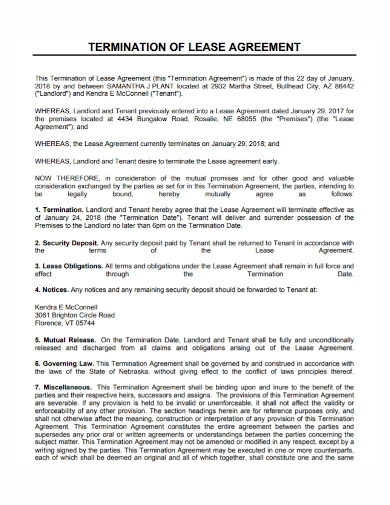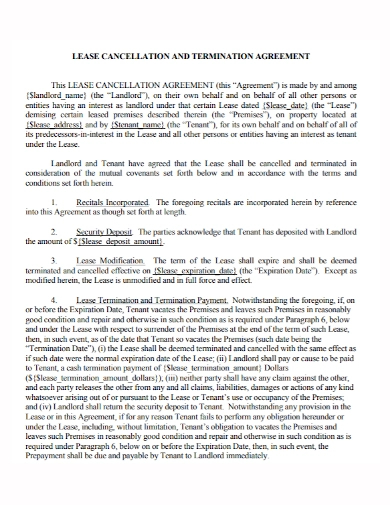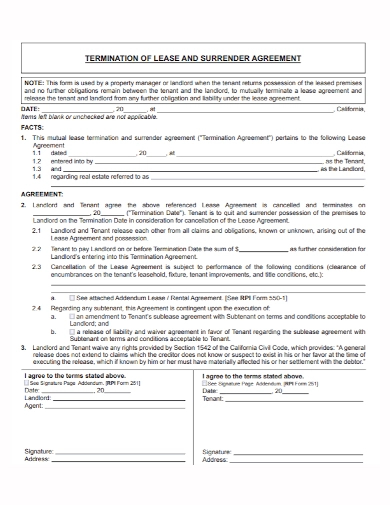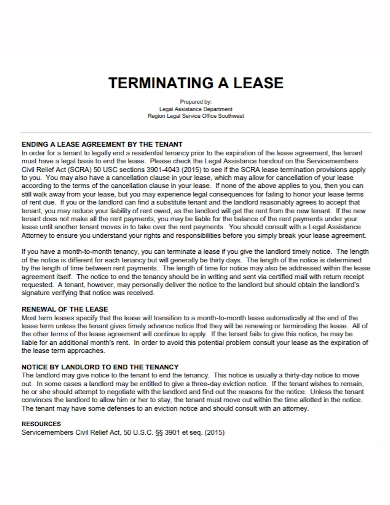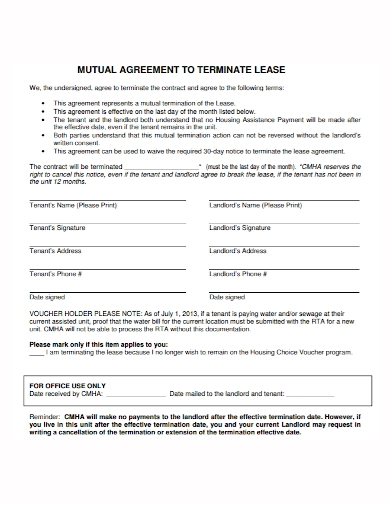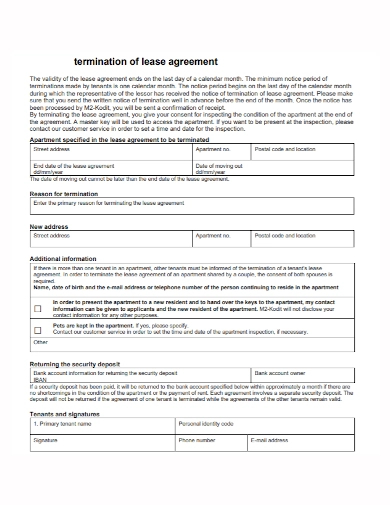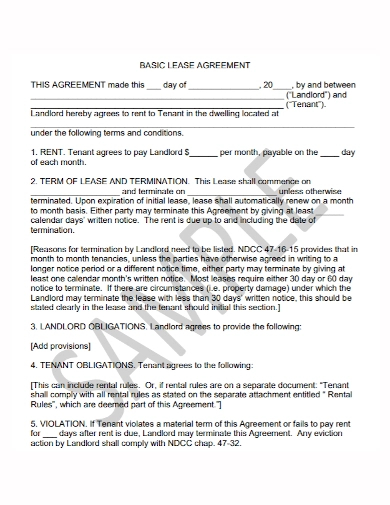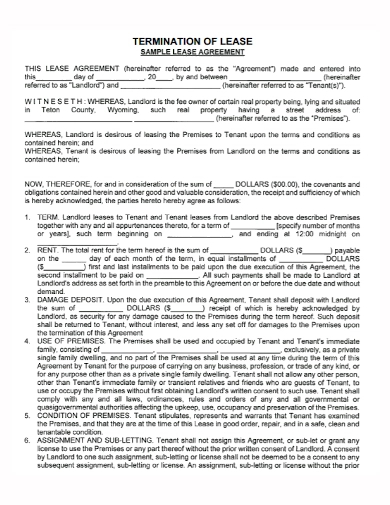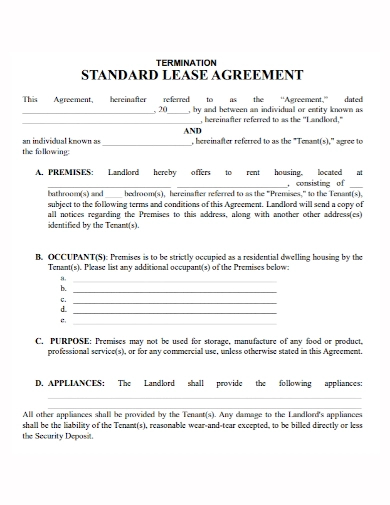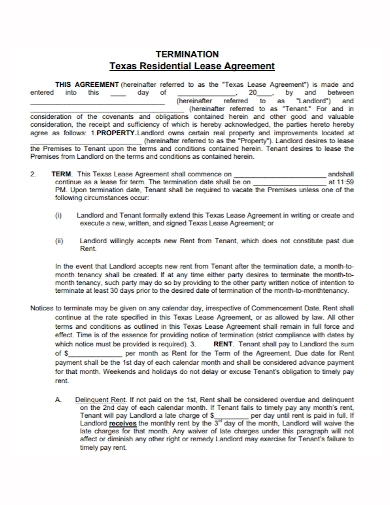After a tenant moves out of a rental property, landlords typically have two weeks to one month to repay the security deposit. Landlords have the right to take money from a tenant’s security deposit if they have good reason and use the authorized procedure. Deductions should be itemized and presented in writing, and any remaining deposit balance should be returned. If the deductions appear to be erroneous, it is critical to contact the landlord. Any deal made should be written down.
10+ Termination of Lease Agreement by Tenant Samples
When your lease expires, you must decide whether to vacate the premises, rent on a month-to-month basis, or sign a new lease. While your landlord may opt to terminate your lease or raise your rent in the future, most states require a 30-day or 60-day notice before the tenant is required to depart the premises. In most jurisdictions, tenants who do not sign a new lease after their current one expires are automatically transferred to a month-to-month lease. Regardless of your decision, it’s always a good idea to convey your intentions regarding the end of your lease in writing to your landlord. The parts that follow will assist you in navigating that procedure.
1. Termination of Lease Agreement by Tenant Template
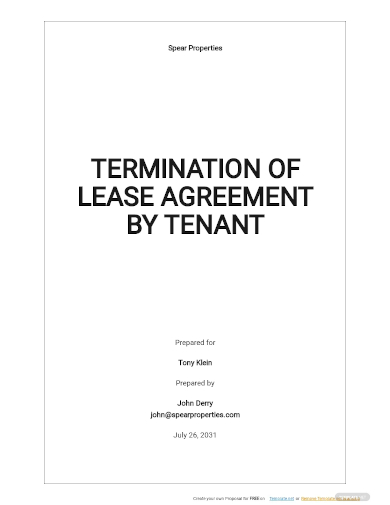
2. Basic Termination of Lease Agreement by Tenant
3. Termination of Lease Cancellation Agreement by Tenant
4. Termination of Lease Surrender Agreement by Tenant
5. Printable Termination of Lease Agreement by Tenant
6. Termination of Lease Mutual Agreement by Tenant
7. Sample Termination of Lease Agreement by Tenant
8. Editable Termination of Lease Agreement by Tenant
9. Standard Termination of Lease Agreement by Tenant
10. Termination of Lease Agreement Occupant by Tenant
11. Termination of Lease Agreement by Residential Tenant
Reasons to Get Out of Your Lease
- Mutual agreement to end – The landlord and tenant(s) may jointly agree to end a lease at any time, with neither party bearing any further duty. If the tenant and landlord decide to mutually terminate the lease, it must be in writing and signed by all parties listed on the lease. The tenant cannot be forced to pay more than the landlord’s actual and reasonable costs (including missed rent and advertising costs, but not compensation for time being spent re-renting the unit), although they may choose to pay more to avoid the dangers of breaking the lease.
- Constructive eviction – A tenant may be capable of moving out and no longer be liable for lease responsibilities if there is a serious health and safety related issue and the landlord is aware of it and has been given a reasonable amount of time to fix it, or if the timeframe or nature of the repairs would end up causing undue hardship on the tenant. To be able to constructively evict, it must be a really serious case. Floods and fires are two examples mentioned in the law. The judge will assess whether the repairs were serious enough to warrant constructive eviction, thus obtaining building inspector reports or other proof will be crucial.
- Servicemembers’ Civil Relief Act – The Servicemembers’ Civil Relief Act gives tenants the right to terminate a lease if they join the military or get military orders to change station or relocate for 90 days or more. This rule applies to leases occupied or designed to be occupied by a service member or a service member’s dependents (spouse, child, or someone for whom the servicemember provided more than half of the individual’s support for the 180 days before the application for relief). To apply this statute, tenants must give the landlord written notice of 30 days and a copy of the military orders.
- Safe Housing Act – Domestic violence, sexual assault, stalking, and child abuse victims can discontinue a lease under the Safe Housing Act if they believe they are in imminent vulnerable to physical harm if they stay on the premises and have an acceptable form of evidence (a restraining order, condition of release, or a criminal complaint). There are very strict rules that must be followed. To terminate a lease under these statutes, tenants with term leases must write a letter to the landlord stating their desire to terminate the contract under Wis. Stat. 704.16 because they and/or their child(ren) are in imminent danger of bodily harm, and give the landlord with a certified copy of the recognized documents (for example, a court order).
- The tenant has died – When a landlord is notified of a tenant’s death, the lease is automatically ended 60 days later (or before, if the lease ends before the 60 days). The tenant’s estate is not accountable for any additional rent beyond 60 days. If the estate surrenders the apartment before the 60-day period has expired, the landlord must offset losses in the same way as if the contract had been broken. Any remaining co-tenants would be covered under the lease (for instance, a living spouse who was named on the lease).
- Illegal lease clauses – Your landlord was under no obligation to act (or attempt to act) on the illegal provision (s). The mere presence of the provision(s) in the lease makes it illegal. Because they drafted the contract, your landlord cannot cancel it without your approval just because it contains an illegal condition.
FAQs
When can a landlord terminate a lease?
If a tenant violates the conditions of the lease or breaks the law, the landlord has the legal right to terminate the lease. The tenant’s infraction must be serious, such as failing to pay rent on time or possessing a dog despite a rule against dogs on the premises. Violations of the law, such as selling drugs on the premises, are sufficient grounds for a landlord to terminate the lease.
How to handle security deposit issues?
After a tenant vacates the rental property, landlords typically have two weeks to one month to repay the security deposit. Landlords have the right to take from a tenant’s security deposit for legitimate reasons and in the authorized manner. Deductions should be itemized and documented in a written document, and payment for any deposit balance should be repaid. If the deductions appear to be incorrect, it is critical to follow up with the landlord. Any agreement that is reached should be written down.
If you want to see more samples and formats, check out some termination of lease agreement by tenant samples and templates provided in the article for your reference.
Related Posts
FREE 7+ Fashion Business Plan Samples in PDF
FREE 10+ Sprint Planning Samples In MS Word | Google Docs | PDF
FREE 10+ Wedding Planning Samples in MS Word | Apple Pages | Powerpoint | PDF
FREE 9+ Monthly Study Planner Samples in PSD | Illustrator | InDesign | PDF
FREE 9+ Sample Curriculum Planning Templates in PDF | MS Word
FREE 10+ Teacher Development Plan Samples in MS Word | Google Docs | Apple Pages | PDF
FREE 10+ Basketball Practice Plan Samples in PDF
FREE 12+ School Business Plan Samples in PDF | MS Word | Apple Pages | Google Docs
FREE 7+ Client Strategic Plan Samples in PDF | MS Word
FREE 11+ Trucking Business Plan Templates in PDF | MS Word | Google Docs | Pages
FREE 7+ Small Hotel Business Plan Samples PDF | MS Word | Apple Pages | Google Docs
FREE 14+ Bakery Business Plans in MS Word | PDF | Google Docs | Pages
FREE 4+ Yearly Lesson Plan Samples in PDF
FREE 50+ Strategic Planning Samples in Google Docs | Pages | PDF | MS Word
FREE 10+ Construction Project Plan Samples in MS Word | Google Docs | Apple Pages | PDF

